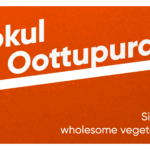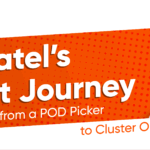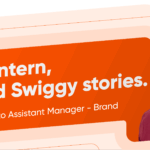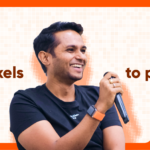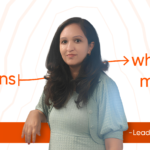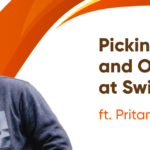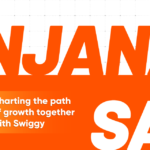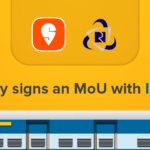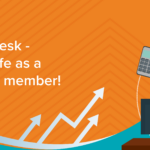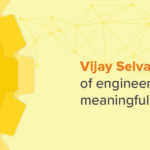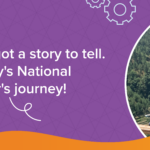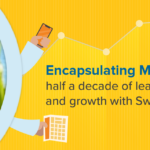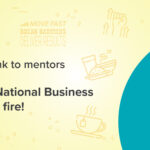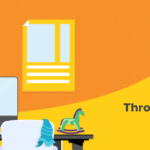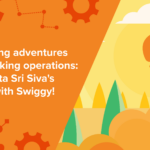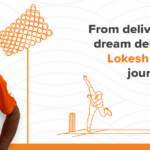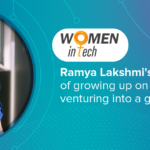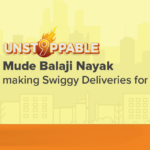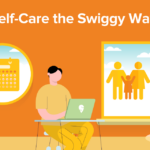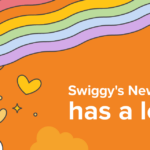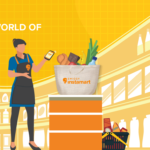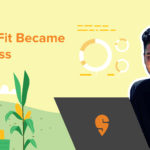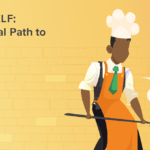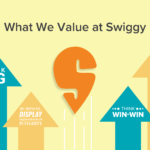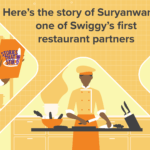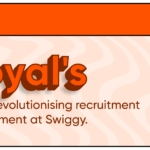His transformative seven-year tenure at Swiggy reflects the impact of a culture built on “stretch” and “user-centric” principles that propelled his growth from designer to design leader.
As an Assistant Vice President – Design at Swiggy, Saptarshi Prakash has built a career defined by meaningful progression. Starting seven years ago as a Lead Product Designer, his role has since evolved into one of strategic leadership.
And his experience as a Swiggster? Steeped in learning, charged with intensity, and driven by purposeful ambition.
In this candid Q&A, Sapta, as he’s fondly called, talks about the power of user-centric thinking, designing beyond pixels, and the quiet joy of grabbing that first morning coffee with his team.

Q1: What’s the most favourite part of your job?
It’s always been the people.
There’s a certain energy that fills the room when a group of curious minds gather around to solve a problem. I love the creative buzz of free-flowing design brainstorms, healthy disagreements, and the thrill of asking bold questions like ‘what if we flipped this entirely?’. There’s nothing quite like watching an ambiguous idea slowly take shape.
But what I value just as much, if not more, are the everyday moments that aren’t related to work at all. For example, our design team doesn’t do cabins or cubicles; every morning, I walk in, claim a spot at our big round table, exchange traffic stories, grab my first coffee, and catch up with the team. It’s a routine, sure, but it’s not a ritual you’ll find in a handbook. Little things like these are the most grounding and joyful parts of my day.

Q2: How was your interview experience? What was your perception of Swiggy at the time?
My interview with Srinath, who’s now my manager, began unconventionally over a coffee at Third Wave Coffee in Koramangala. That casual 30-minute chat later turned into a 2-hour discussion on design, values, leadership, and the kind of culture we both believed in.
Towards the end, I remember saying, “I’d love to work under you someday.”
Srinath smiled and gently said, “Not under me. With me.”
That one sentence stayed with me. It spoke volumes about the kind of leader he is and the kind of organisation Swiggy is.
A few days later, I visited the office and met a few folks from the design and product teams. Officially, those were interview rounds. But they didn’t feel like that. They felt like thoughtful conversations between people who were curious about the work, ways of thinking, and what we could build together. By the end of it, I wasn’t just interested in the role – I wanted to be a part of this team.
Q3: Tell us about the beginning of your Swiggy ride. What was your role when you joined the company? How has that changed over the years?
When I joined Swiggy as a Lead Product Designer, the word “Lead” was more reflective of ownership than people management. My day-to-day focussed on refining user flows, polishing pixels, and making sure that every touchpoint in the consumer experience felt intuitive and meaningful. Back then, my responsibilities were tightly defined: identify problems, design intuitive solutions, refine interactions, and ship features that felt human. But like everything at Swiggy, that scope has expanded significantly.
Today, as Assistant Vice President – Design, the canvas has widened. I find myself working at the crossroads of design and strategy to create a superior experience for our consumers. I’ve moved from zooming in only on interaction patterns to zooming out and aligning cross-functional teams. From tweaking flows to shaping new talent, I now spend time mentoring designers, fostering team alignment, and embedding design thinking across Swiggy.
It’s been fast-paced and demanding, but while responsibility evolved, the thrill of building something transformative has never faded.

Q4: You often discuss design thinking beyond aesthetics. How do you foster a culture at Swiggy that integrates user-centric design from ideation through launch?
I genuinely believe all humans, designer or not, are inherently good problem-solvers. Think about the everyday challenges we face. You miss your cab, it starts raining, and there’s no umbrella. Five guests show up unannounced, and you’ve only got three laddoos. Somehow, we always find a way. These are everyday design problems, just without the Figma file.
So why do we lose that scrappy instinct at work? We weirdly start creating invisible rules for ourselves, over-indexing on frameworks and best practices that, while useful, can stifle our raw creativity.
To combat that, I encourage teams to bring that same street-smart thinking to the table, especially in the early stages of a project. Because design isn’t just aesthetics or structure, it’s problem-solving in a different avatar and we’re already incredible at solving life’s messiest problems. We just need to trust that muscle a bit more at work.
Q5: What emerging design trends or technologies (like AI in design) do you see most impacting food delivery and quick commerce, and how is Swiggy’s design team preparing?
Well, how can we talk about design trends without talking about AI? We’re exploring its impact on two fronts. The first is about making our own lives easier: using AI to automate the mundane and help our teams move faster without losing quality. We’re even exploring how to get AI to be a creative partner in our design process, not just a tool.
But the part I’m truly obsessed with is the second direction: imagining a world where AI is integrated into everything. We’re moving beyond interfaces that simply respond to prompts and instead of that, we’re imagining systems that understand context.
By learning from the past orders, the time of day, the weather outside, or even what your friends are eating, AI can transform a transactional service into something that feels intuitive and almost invisible, like an ultra-efficient butler (think Alfred from Batman) who knows your preferences inside out. You don’t have to spell things out. A slight nod, a wave, or a word or two would be enough. That’s the kind of future we are imagining and designing towards, where interfaces don’t just respond, they anticipate. And when done right, that makes the experience feel less like an app and more like magic.
Internally, our design team is right in the middle of this shift. We are actively learning how to design for AI, with AI, and at times even as AI.
Q6: What’s your biggest learning from your manager, your team, or working at Swiggy in general?
There’s one moment I always go back to.
We were struggling with a tricky product decision when the users’ needs directly clashed with the business goals. I turned to Harsha, our CEO, trying to get his perspective on how to move forward. Honestly, I expected a long, layered discussion. Instead, he said something that cut through the noise:
“Sapta, anything that is not user-friendly can never give us business returns in the long run.”
That one sentence changed how I think. It was simple. Direct. Clear. But also deeply strategic. In just a few words, it reinforced something I’ve come to value immensely at Swiggy—clarity of thought. Since that day, this has become a lens I use for almost everything: Start with the user. Always. Because when you consistently do what’s right for the user, the outcomes, product, business, and team start to align naturally.
It’s one of the most powerful lessons I’ve learnt here, and one that continues to shape how I lead, build, and solve.
Q7: What’s one word that captures your experience at Swiggy so far? Tell us why you chose it.
If I had to pick one word, it would be “Stretch.”
Because that’s exactly what Swiggy does, it stretches you. Sometimes it stretches your creativity, sometimes your collaboration muscle, and yes, occasionally even your calendar. But always in a way that leads to growth.
Every challenge here has nudged me out of my comfort zone, pushed me to think bigger, and helped me uncover strengths I didn’t know I had. It’s not always easy. But it’s always meaningful. This stretch has made this journey truly transformative.
Q8: How do you balance advocating for bold, innovative design with business and technical constraints at Swiggy? Can you share an example of successfully navigating this tension?
The key is to innovate without disrupting the basics – things like usability, business needs, and technical feasibility. This mindset wasn’t something I introduced. It has been ingrained in Swiggy’s DNA from the very beginning.
But while that sounds simple on paper, striking that balance is anything but easy. What I often remind our team is that bold, innovative designs don’t need to reinvent everything. The magic is in the small, thoughtful details like a subtle twist in a familiar flow, a distinct micro-interaction, or an unconventional copy tone that makes something feel fresh.
We aim to bring that “something special” into every experience we craft, no matter how small. A great example is our work on Snacc. On the surface, it followed all the established norms of food discovery and ordering. But it’s the visual layer where we pushed boundaries. Without altering the core mechanics, we created an experience that felt playful and distinctive, purely through visuals. It’s a great case of innovation through nuance, not disruption.

Q9: What’s one Swiggy value you resonate with the most and why?
“Stand up, disagree, and fully commit.”
It captures the essence of a culture that’s not just open but brave. This culture allows disagreement and welcomes it. At Swiggy, your voice matters, whether you’re leading a function or just getting started. There’s space to challenge ideas, ask questions, and offer a different lens.
It’s a delicate but powerful balance of individuality and unity. And I think that’s what makes our collaborations not just productive, but deeply respectful and effective. The deeper impact of this value lies in what comes after; once a direction is chosen, no matter whose idea it was, we move forward together with clarity, conviction, and a shared sense of ownership.




